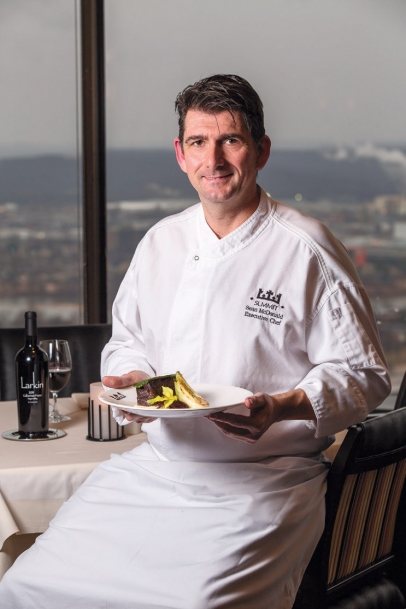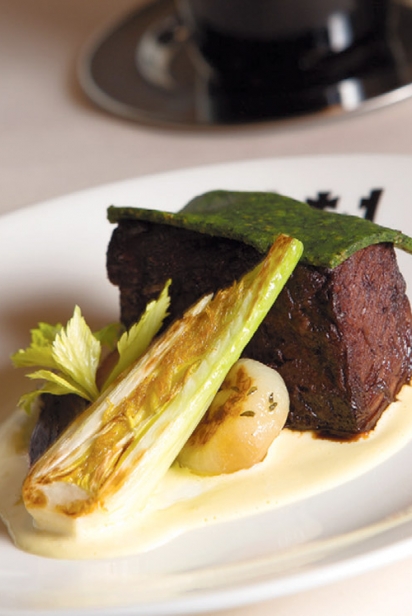Upwardly Mobile
Sky’s the Limit for Well-Seasoned Top Chef at Summit Club
Chef Sean McDonald sat at a table on the private club’s 32nd floor, chatting with an acquaintance. The new Tulsan vowed to raise the culinary bar at the historic and fabled kitchens of the downtown Summit Club, the decades-old institution, managed by Tony Zaranti, CCM and a cadre of committed professionals. The continued success of the Summit feeds its own inertia; Chef McDonald just wants to add some gastronomic wallop.
The path for a dynamic menu change at an iconic establishment is nearly as complicated as the route that takes a blue-collar kid from London to a culinary institution at the top of a Tulsa skyscraper. McDonald has the chops to be an executive chef; his road to Oklahoma is dotted with solid life experiences and multiple résumé builders.
McDonald grew up in a no-frills, work-hardy family in the modest suburb of Chingford, northeast of London. His dad, John, was a Barclays bank messenger who delivered parcels, picking up extra work on Saturdays, while his mom, Mary, was a waitress. His two-year-younger brother, Mark, joined the military at 16, while his six-year-younger sister, Lucy, performed her role of minor irritant to big brother. His loving home was not a gastronomic environment.
The future chef was not influenced by mom nor grandma. Although he did some puttering in the kitchen, McDonald did not act as sous chef when mom cooked various soups during the week for the family or the ubiquitous pot roast on Sunday, braised beside carrots and a variety of other aromatic, root vegetables. Mom made desserts regularly until Sean “kind of porked up.” Going out to dinner was reserved for birthdays and such.
Regular visits to a restaurant became common and forever when a 14-year-old McDonald began washing dishes for a few quid in basic restaurants, like a carvery—a carving station with beef, turkey and ham mounted on vertical spits. The lad from the outskirts of town shaved off slices of protein for each customer and folded it neatly against their wilted buffet-salad fixings. He worked nights, hitching a ride home from his mom after her shift or rousing his dad from a sleep in front of his favorite television show late on a Friday or Saturday to fetch him. Mostly, he hopped a bus.
The prospect of cooking lingered in the back of his mind. McDonald’s passion to be a chef has always been strong. Perhaps a mentor would have directed him towards higher-quality establishments, closer to central London, a little sooner.
At 16, he entered 10,000-student Waltham Forest College in London to pursue training in culinary arts. For six months, the diligent student worked in the kitchen at a Harrods’s-like department store, Fortnum & Mason, an architecture-rich store with four restaurants. The venerable establishment opened its doors in 1707 and is still the Queen’s official grocer. On Saturdays, McDonald made large trays of tea sandwiches and manned the carving station. Realizing that he was not really cooking, the ambitious teenager redirected his career path.
McDonald moved to the Celebrities Restaurant at the Hampshire Hotel in Leicester Square by London’s National Gallery. He learned to cook under the disciplinarian eye of a tall, skinny man who wore a tall, skinny toque perched above his scary eyes. The chef was Colin Button, who once worked at Buckingham Palace and had great butchery skills. During his stint with Button, the improving cook met a female sous chef who connected him with a man who was hiring at the fine-dining kitchen for the Park Lane Hilton in Central London.
He took the job, confident of his skills. Turned out, McDonald was still a work-in-progress. The sous chef tormented him ala Gordon Ramsay, until the day the tormentor left for a Michelin-starred restaurant across town. The tormented had worked hard and his skills improved. He worked up through various kitchen stations in the Hilton for a year. With 200 clients a night, the hectic pace of the restaurant was not McDonald’s cup of tea. He had reached a point of chef notoriety that made it easier for him to select better positions, no interviews required.
He danced around several upscale kitchens, honing his craft, adding to his reputation.
Seeking a restaurant that inspired him, McDonald embarked on an unconventional pilgrimage that lasted several months. Whether it was at Michelin three-star restaurant or an ordinary establishment, he showed up at the kitchen door early in the morning, introducing himself to the chef-in-charge, asking to be put to work for a day to see if it might be a match. The process employs a French term, “stage” (staa-zha), meaning a period of probation or training. A cookfriend told McDonald of a “crazy Italian” that he needed to check out, Chef Fabio Trabocchi. Pursuing the lead, he showed up at another doorstep, one that became home.
After working a shift in his kitchen, McDonald knew he had to work for Trabocchi, saying to the journalist, “Everything else, we would just have to work out later.” His new mentor didn’t particularly care about food cost, he just wanted to make great food.
Eventually, Trabocchi was offered a plum in America, one of many countries in which he had previously worked. Ritz-Carlton Tyson’s Corner, Virginia, located within eyeshot of Washington, DC, asked him to create a new restaurant for the hotel. The result became the five-star five-diamond restaurant called Maestro. McDonald followed him to the Ritz, not considering he would stay in the United States for long. Yet his American stopover was extended when the Ritz- Carlton persuaded him to become a principal chef within their organization.
McDonald became the executive chef at the Ritz-Carlton Palm Beach, while James Beard Award winner Trabocchi opened, and still operates, several restaurants in the capital city, where he is a “big cheese,” according to his protégé. At the Summit, Chef McDonald will apply the lessons learned from his awarded kitchen bosses.
Rigorous training of personnel throughout the organization is a hot point for the executive chef. He sees service as a crucial path to satiating diners. The front staff must understand the menu items and be adept at explaining key ingredients and cooking techniques. The Summit has a diverse age range of members who have shared their dining needs with the new lead chef. So that he can blend his culinary vision with their input, he continues to listen intently.
Chef McDonald wants his dining room clientele to have the choice of lounging over a multi-course meal or, if time is at a premium, still having the chance to savor some prime beef. Along with the option of a full menu, his bar food offers savory snacks that can be shared with other mates.
His tasting menu (fixed-price menu with four small-plate offerings and wines to match each) allows diners the option to enjoy creative “off-the-menu” courses at a great value. A “Chef Special” with local, seasonal ingredients, influenced by McDonald’s special twists, may be offered on the carte du jour. A monthly food and wine club is on the planning table. The influx of 30-something members widens the stance of the membership’s menu expectations that will drive the character of the Summit’s cuisine.
Part of the food education process is making sure the membership knows what is available—what is seasonal, for example—and how that translates into a vibrant menu that provides pristine local products during their prime season. The efforts of McDonald and Zaranti to elevate the Summit, temporarily distracts the chef from the longing for his wife, Jill, and 10-year-old daughter, Alexis, finishing out the school year in Florida.
Asked what “Welcome to Tulsa” meal he would prepare upon their arrival, McDonald chuckled. While he prefers an eclectic, chef-driven dining room, his family has other ideas. “My daughter likes pasta and butter,” reports the chef, smiling. “Don’t bother with chicken and such, just pasta and butter.”
Jill, on the other hand, is a steak house and lobster lover—a club diner, he explained. Inserting an English colloquialism, the amused chef suggested that if a lobster tail and a juicy steak is in front of her, “She is happy as Larry.”
For Chef McDonald, sitting at a round table with the two of them, happily sharing whatever food they like, is the real gravy.






